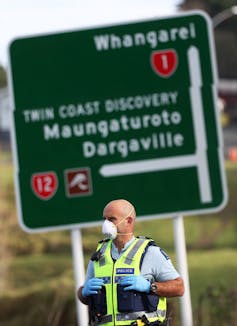With lockdowns easing for the rest of New Zealand, Auckland becomes the elimination frontline
- Written by Michael Plank, Professor in Applied Mathematics, University of Canterbury
The number of new cases in New Zealand’s Delta outbreak is now on a downward trend and we have a good chance of eliminating it, even as lockdown restrictions ease for most of the country from tomorrow.
After a peak in case numbers during the weekend of August 28-29, the Ministry of Health reported only 20 new cases for three consecutive days, of which most were already in isolation during their infectious period.
This downward trend shows alert level 4 restrictions and contact tracing are working, bringing the effective reproductive number of the Delta variant down well below 1.
Our latest estimates suggest the R number is about 0.4, very close to the value observed in the March-April outbreak in 2020, the last time the entire country was under the strictest lockdown.
We know that Delta is as much as twice as infectious as the original wild-type variant, but the level 4 lockdown measures are proving just as effective so far.
This is perhaps surprising, given that two Australian states, New South Wales and Victoria, have failed to bring Delta outbreaks under control. The R number in New South Wales has been consistently above 1 for more than two months, leading to record numbers of infections and putting the health system under considerable pressure.
New Zealand can still eliminate the current outbreak, but with the Delta variant, nothing is guaranteed and we can’t be complacent.
Additional safeguards
From Wednesday, restrictions will ease for New Zealanders living outside Auckland. The new “Delta alert level 2” has some additional safeguards, including mandatory mask use and record keeping, two-metre distancing in most public venues, and gathering limits of 50 people inside and 100 people outside.
Some will be frustrated at the ongoing restrictions given there are no current cases in many parts of the country. But it’s important to remember we can’t seal Auckland off from the rest of New Zealand completely.
 Essential workers travelling through Auckland will be tested regularly.
Fiona Goodall/Getty Images
Essential workers travelling through Auckland will be tested regularly.
Fiona Goodall/Getty Images
Essential workers still need to travel and goods have to be moved around the country to keep supermarkets stocked. Regular testing of essential workers who need to cross the boundary has been introduced to reduce the risk. But no boundary is watertight and just because most regions have remained COVID-free so far doesn’t guarantee a case won’t emerge.
The additional restrictions will reduce the risk of superspreading events like those that triggered the lockdown. This is key to avoiding another explosive outbreak in a different part of the country, which could send us all back to square one.
Even with the additional restrictions, alert level 2 is unlikely to prevent an outbreak from growing, so this is a calculated risk. We need higher community testing rates in all regions. Combined with more extensive wastewater testing, this will help us pick up any cases that do leak out of Auckland before they have a chance to spread too far.
How much longer Auckland has to wait
Should the virus find its way into essential workplaces, it could cause a resurgence and prolong the outbreak significantly. New South Wales and Victoria both seemed to have their Delta outbreaks under control, only to see case numbers rise again as the virus spread among essential workers.
The best way to prevent this is to drive case numbers down as quickly as possible. That means everyone doing their bit to deny the virus any chance to spread. In other words, Aucklanders will need to stick to their bubbles.
On the current trend, case numbers could be into single digits next week. If all new cases are close contacts who have been isolating throughout their infectious period, Auckland may be able to safely move to alert level 3 then.
However, it’s also possible the outbreak will have a long tail. Each time Delta finds its way into a new household, it tends to rapidly infect everyone in that bubble. This could potentially lead to a significant number of new cases and cause the outbreak to drag on. Again, denying the virus any chance to find new bubbles to infect is the best way to stamp it out quickly.
The transition to lower alert levels is a dangerous time. It only takes one case to slip through to spark an uncontrolled chain of transmission. It’s better to wait a few extra days at the higher alert level than to risk a resurgence that could set us back weeks.
If we keep doing what we’re doing, we have an excellent chance of eliminating this outbreak. This is our best strategy as it will minimise health impacts and give us the chance to live in relative freedom while we complete the vaccine rollout.
As experience in Australia shows, we need to get it right the first time. With Delta we might not get a second chance.
Authors: Michael Plank, Professor in Applied Mathematics, University of Canterbury





